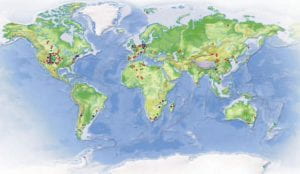If you were an omnipotent palaeontological planner, with unlimited wealth, how would you set about locating as many new dinosaur species as possible. Should you spend your money on sending palaeontologists to new countries or new sedimentary basins that had not been explored before, or should you hire many new palaeontologists, and so increase the overall work rate?The answer depends on what you want. If you want the maximum number of new dinosaurs, hire more palaeontologists; but if you want the maximum number of valid new dinosaurian species, send those palaeontologists to new, previously unexplored sedimentary basins.
 The recent dramatic upturn in the numbers of new dinosaurian genera being named, from 1980 onward, is matched, and probably driven, by a similar exponential rise in the number of palaeontologists publishing papers about dinosaurs (Figure A, right). The curve of valid dinosaurian genera, however, matches more closely the discovery curves of numbers of new countries and new sedimentary basins exploited (Figure B, right). When the cumulative number of valid dinosaurian genera is plotted against cumulative totals of countries, basins, and workers, the best fit is against number of countries, and then number of basins. These correlations are confirmed by fitting regression lines of plots of numbers of new dinosaur species, and valid new dinosaur species, against numbers of authors, basins, and countries.
The recent dramatic upturn in the numbers of new dinosaurian genera being named, from 1980 onward, is matched, and probably driven, by a similar exponential rise in the number of palaeontologists publishing papers about dinosaurs (Figure A, right). The curve of valid dinosaurian genera, however, matches more closely the discovery curves of numbers of new countries and new sedimentary basins exploited (Figure B, right). When the cumulative number of valid dinosaurian genera is plotted against cumulative totals of countries, basins, and workers, the best fit is against number of countries, and then number of basins. These correlations are confirmed by fitting regression lines of plots of numbers of new dinosaur species, and valid new dinosaur species, against numbers of authors, basins, and countries.
Finding the best correlate of numbers of genera (A, above), and numbers of valid genera (B, below). Numbers of authors active at any time is the best match with total numbers of genera (A), but numbers of valid genera correlate better with number of basins and number of countries.
New locations are not always necessary of course. Genuine new dinosaurs are still found in well-trodden areas. For example, the Wealden rocks (Early Cretaceous) of southeast England have been a well known source of dinosaurs since the 1820s, and yet remarkable new taxa are still being found, including Baryonyx in 1983, Neovenator in 1996, Eotyrannus in 2001. More often, however, new basins/regions are the source of repeated new finds, recently most notably the Liaoning basin in China, source of over 50 new genera of dinosaurs and birds since the first genus was named in 1992.

Map of the world today showing key dinosaur localities (purple, Triassic; green, Jurassic; orange, Cretaceous).

